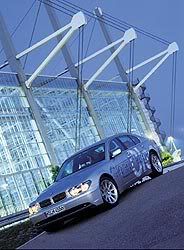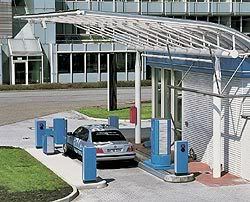Canadian Driver Magazine wrote:Any gasoline engine can theoretically be adapted to use hydrogen fuel and provide the various benefits offered by the gas in the type of vehicles we're already driving.
It's worth revisiting BMW's experiments with hydrogen as a fuel for internal combustion engines - a project that has been going on for many years now. The Bavarian automaker is so convinced of the viability of hydrogen that it's into its fifth generation test sedan using that fuel. In fact, BMW has made a serious commitment to the future of hydrogen as a vehicle fuel and is claiming that its small fleet of hydrogen-fuelled sedans are the first such vehicles in series production in the world.
I once rode from downtown Munich to the city's airport (a lengthy trip) in a fourth generation BMW 750hL and even "filled up" at a hydrogen service station located right on the airport property. It was an interesting experience, but a common enough routine at Munich airport where many of the vehicles used around the facility, including apron buses, are hydrogen-fuelled.
BMW has been operating 7-Series hydrogen-powered sedans on a daily basis in both Munich and Hanover. When running on hydrogen, the 750hL 12-cylinder engine develops 204 horsepower, tops 100 km/h in 9.6-seconds and is capable of a top speed of 226 km/h. The car's 140-litre cryogenic hydrogen tank gives the fully-equipped luxury car a range of 350 km. The cars are "dual fuel" units capable of being run on gasoline when needed. After all, you won't find a hydrogen filling station on every street corner just yet.

The latest BMW hydrogen car is the 745h, which uses a 4.4-litre V-8. The only major modifications to make the big BMW's engine run on hydrogen involve the intake ports, which have additional injector valves for hydrogen. The engines come off the same production line as other BMW powerplants and are installed in the vehicle using the same assembly techniques. BMW has also produced a concept Mini powered by hydrogen.
BMW says that its hydrogen vehicles are just as safe as gasoline-fuelled cars. The hydrogen is stored in a double-walled steel tank behind the rear seat back - resulting in some loss of trunk space. The fuel is "cryogenic," or in an ultra low-temperature condition of minus 253 deg C. Safety has been assured by numerous crash tests. BMW points out that even in a very severe nose-to-tail collision in which the colliding vehicle reaches the hydrogen tank, the double-walled tank would not leak. Even in the severest possible crash, which would probably involve little chance of occupant survival, the hydrogen cannot explode, according to BMW. [...]

At Munich airport's unique filling station, hydrogen is produced right on the premises in a facility comprising just a couple of small shipping container-sized buildings. The hydrogen is dispensed automatically using a robot arm which reaches out in response to inserting a credit card and probes for the filler location. It even lifts and replaces the "gas cap" flap.
The downside to all this is cost, though it should be borne in mind that if hydrogen was in wider use, the price per litre could drop dramatically. At the Munich airport filling station last time I checked, hydrogen costs close to 80-cents a litre and the energy density in the fuel by volume is a quarter that of gasoline
[due to 11 times lesser density for LH2, although it gives 3 times the energy per unit mass]. You need four litres of hydrogen to travel the same distance you would in a gasoline-powered vehicle on one litre.









